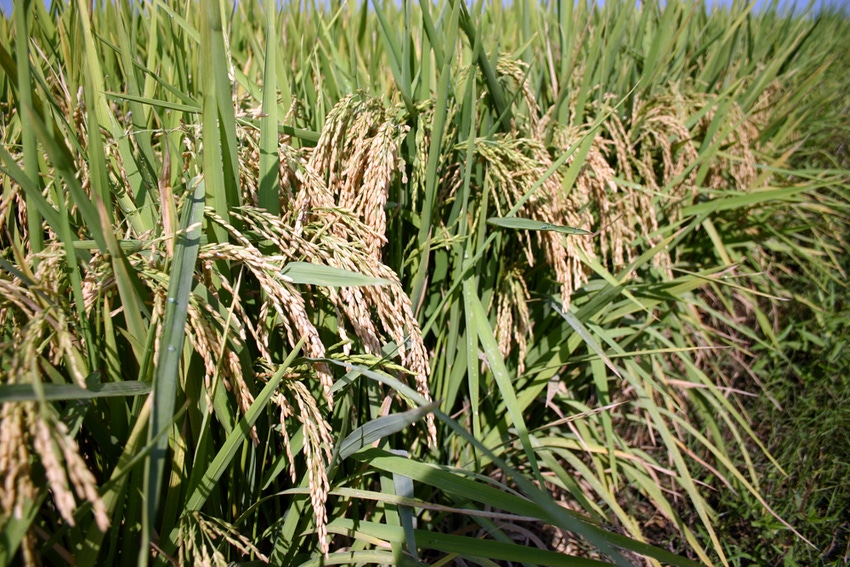
EPA approves Sercadis for full federal label in 2014
Fungicides have been used on rice since 1977, the LSU AgCenter's Don Groth said. Sheath blight in rice became a problem as more rice farmers started growing soybeans in rotation with rice, and the beans were also susceptible to the sheath blight pathogen which causes aerial blight. Before that, farmers rotated rice with pasture for cattle.
February 25, 2014

The Environmental Protection Agency has granted a Section 3 federal registration for the new fungicide, Sercadis, for use on strobilin--resistant sheath blight in the rice-growing southern states.
Sercadis, which contains the active ingredient Xemium, has been available under a Section 18 emergency exemption to fight outbreaks of the resistant sheath blight in Louisiana for the past two growing seasons.
The strobilin-resistant sheath blight, which is the same disease as aerial web blight in soybeans, initially was found in a South Louisiana parish in 2012. It has continued to spread in South Louisiana and could move to other states, according to the LSU AgCenter’s Don Groth.
“If it happened here, it can happen somewhere else,” said Groth, an LSU AgCenter plant pathologist based at the LSU Rice Research Station in Crowley, La. “We think we have detected it further north into Allen and Evangeline parishes.”
A speaker at the Rice Technical Working Group bi-annual meeting in New Orleans, Groth said the continued use of the same fungicide in both rice and soybeans led to the development of resistance. “If you challenge the population enough and put selection pressure against it, a resistant pathogen will develop.”
BASF, the manufacturer of Sercadis, had been hopeful of receiving full registration for the product early in 2014. Alvin Rhodes, BASF technical service representative from Madison, Miss., discussed it and Sharpen herbicide during a new products session at the USA Rice Outlook Conference in St. Louis in December.
“Over the last few years, resistance has developed where they cannot use any other compound, but Sercadis has done an excellent job of controlling this sheath blight,” he said. “Sercadis can control not only the resistant but also the non-resistant. In 2014, it should be labeled in all rice-growing states for control of rhizoctonia solani or sheath blight.”
Sheath blight is a disease that seems to occur annually in southern rice fields or as aerial web blight in soybeans.
“Sercadis should be applied early, more as a preventative treatment, at the rate of 6 to 6.8 fluid ounces per acre and applied by air at seven to 10 gallons of water per acre for control of sheath blight,” said Rhodes.
“Xemium is part of a compound known as Priaxor, which is a pre-mix of Xemium plus Headline, and it does an excellent job of providing broad spectrum disease control and for plant health benefits on soybeans and corn.”
The use of Sercadis at the higher rate in 2013 made the product much more effective, Groth said. The previous rate of 4.5 ounces per acre was increased to the higher rate. Application is normally most effective when applied around the boot stage of rice.
“The consultants I talked with liked it,” Groth said. “They thought the rice looked like fields sprayed with Quadris when it first came out.”
Groth said he is testing several new fungicides that may be available in two to three years. “There’s potential we will have resistance to Sercadis in five to six years,” he said. “If we have another product we could rotate with Sercadis, that would be the ideal situation.”
Fungicides have been used on rice since 1977, Groth said. Sheath blight in rice became a problem as more rice farmers started growing soybeans in rotation with rice, and the beans were also susceptible to the sheath blight pathogen which causes aerial blight. Before that, farmers rotated rice with pasture for cattle.
Much of Groth’s research has been accomplished with check-off money paid by farmers based on 5 cents for every 100 pounds of rice sold.
“Without this funding resource, the disease research could not have been done,” Groth said. “Getting a product like Sercadis approved by the EPA requires support from scientific data that our research provided.”
“These check-off dollars are well spent on the hard work by our staff at the station,” said Steve Linscombe, resident director at the Rice Research Station. “I’ve had many farmers tell me they would no longer be in business if it weren’t for our research, and much of that work could not be done without the check-off funds.”
For more information, go to http://deltafarmpress.com/rice/resistant-sheath-blight-changing-practices-louisiana
And http://deltafarmpress.com/rice-sheath-blight-fungicide-treatment-thresholds
You May Also Like



